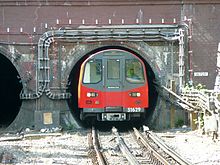
Back Gàlib ferroviari Catalan Fahrzeugbegrenzungslinie German Gálibo ferroviario Spanish Laadimisgabariit Estonian Gabarit ferroviaire French Batas ruang bebas ID Sagoma limite Italian Omgrenzingsprofiel Dutch Skrajnia kolejowa Polish Габарит подвижного состава Russian
| Part of a series on |
| Rail transport |
|---|
 |
|
|
| Infrastructure |
|
|
| Service and rolling stock |
|
| Special systems |
|
|
| Miscellanea |
|
|

A loading gauge is a diagram or physical structure that defines the maximum height and width dimensions in railway vehicles and their loads. Their purpose is to ensure that rail vehicles can pass safely through tunnels and under bridges, and keep clear of platforms, trackside buildings and structures.[1] Classification systems vary between different countries, and gauges may vary across a network, even if the track gauge is uniform.
The term loading gauge can also be applied to the maximum size of road vehicles in relation to tunnels, overpasses and bridges, and doors into automobile repair shops, bus garages, filling stations, residential garages, multi-storey car parks and warehouses.
A related but separate gauge is the structure gauge, which sets limits to the extent that bridges, tunnels and other infrastructure can encroach on rail vehicles. The difference between these two gauges is called the clearance. The specified amount of clearance makes allowance for wobbling of rail vehicles at speed.
- ^ "Glossary". NetworkRail.co uk. Network Rail. Archived from the original on 6 May 2009. Retrieved 15 May 2009.
© MMXXIII Rich X Search. We shall prevail. All rights reserved. Rich X Search